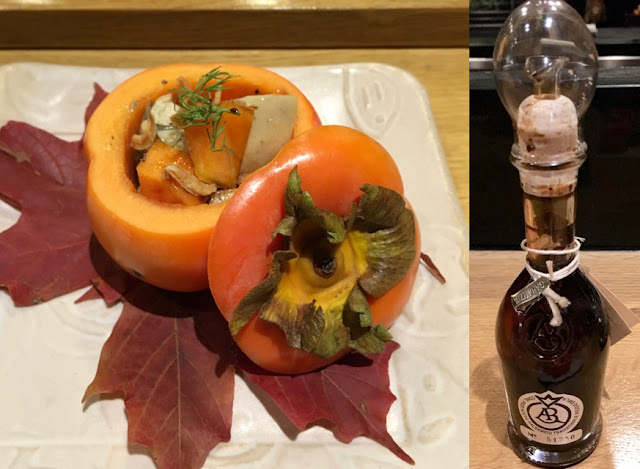Monday, December 14, 2020
Sushi Taro "regular" kaiseki box "普通”の寿司太郎会席弁当
Tuesday, October 27, 2020
Special Kaiseki box from Sushi Taro v2 寿司太郎特別会席弁当二回目
We had the second take-out special kaiseki box from Sushi Taro. Again, this was amazing. We just wanted to record what we enjoyed.
Wednesday, November 23, 2016
Sushi Taro Michelin ☆ Part 1, すし太郎 ミシュラン☆ その1
Tuesday, October 13, 2020
Special take-out Kaiseki box from Sushi Taro 寿司太郎のテイクアウト特製会席弁当
Prior to COVID the omakase counter at Sushi Taro was our special-occasion-go-to place. As a matter of fact, we had a reservation in March this year but because of COVID, that got canceled. I knew for some time that, although the restaurant was closed, Sushi Taro has been doing take-out. But getting there either from home or work for the pick-up was impractical. Since I started thinking about the NewYear “Osechi” 御節 from Sushi Taro, I contacted them. I was delighted to find out that they are going to do Osechi for the next New Year and I quickly placed an order. During that interaction, I learned that they do special omakase kaiseki boxes-to-go and that they can deliver. I quickly placed an order. Delivery was scheduled for Friday at 5pm. We were like little kids in anticipation. I even "just happened" to come home from work a bit early for the delivery. It arrived in two, two-tiered (bento or modified jubako?) boxes. (a total of four boxes with three compartments each). We initially thought we got two identical sets but when we opened the second box, surprise! We were totally blown away. All compartments contained many wonderful different dishes. The first one had some cooked dishes, two different kinds of sushi. The cooked dishes in the top tier were still warm.
Saturday, May 22, 2010
Sushi Taro, Dupont Circle, Washington DC 寿司太郎
This time we started off with home-made umeshu 梅酒 aperitif with green plum simmered in syrup or "kanroni" 青梅の甘露煮, a very nice refreshing start, which was followed by their signature appetizer Gomadofu 胡麻豆腐 topped with Maine sea urchin, real wasabi (every time wasabi was served, our chef grated a wasabi daikon root with a traditional sharkskin grater--the difference between this wasabi and the usual fake one from the tube was remarkable). Since it was in season, the next was Junsai ジュンサイ in sweet vinegar and yuzu 柚子. Junsai was very fresh with thick gelatinous layers. It matched perfectly with gentle sweet vinegar sauce highlighted with a bright yuzu flavor. (Masa showed us the fresh yuzu they had just received--the very small green kind). We then moved to a simmered dish; Hiryouzu 飛龍頭 and shrimp shinjou 海老しんじょう in yuba 湯葉 sauce. This was a nice comforting dish and well-prepared, if not spectacular. Next came a huge and fresh Pacific oyster (cut into three pieces) from Washington State, Japanese call it Iwagaki oyster 岩牡蛎, on the half shell with a lemon wedge and okinawan salt. This was so good (you may have noticed we are partial to raw oysters). It went so well with the sake we were drinking; a nice fresh ocean taste and, without any special sauce or seasoning, it lingered pleasantly in the mouth for a while. Again seasonality is important here. "Ayu" 鮎 is in season. Japanese, especially Kyotoites, are very fond of this small fresh water river fish and we had this fish quite a few times in Kyoto. The Ayu which had been marinated very delicately in soy sauce and sake 祐庵地 was served butterflied and grilled 鮎の開き祐庵焼き. I like this rendition much better than the customary "shioyaki"塩焼き or salt grilled, which is usually served on a bed of salt and pine needles. Somewhere between these dishes, we had assorted "Hassun" appetizers 八寸 with 8 small tasty morsels; kinome-miso dengaku 木の芽味噌田楽, "aburana" with yuzu-miso アブラナの柚子味噌和え, lightly marinated firefly squid 蛍イカの沖漬け, "tamago-dofu" 卵豆腐, a small savory egg custard square with edamame paste, salt-cured shirako 白子 with vinegard daikon strips, garlic sprouts 芽ニンニク with miso-marinated Manila clams. All were fantastic. The only slight disappointment being the dengaku due to the quality of the tofu which could have been better. The salt cured "Shirako" or cod sperm sac (which does not sound appetizing) was delicate and tasty.







































